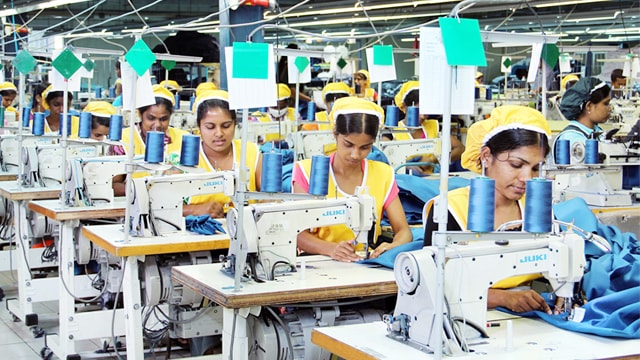Achieving best results from minimum possible resources is the key to success. This not only brings success but makes the organization competitive and sustainable. Improving productivity has always been one of the prime focuses of Industrial Engineering. To make the same happen, innovation in the product or the process, is one of the most sought-after practice in order to make things easy and enhance the quality of the end-product. Just buzzwords in apparel manufacturing industry, Value Analysis and Value Engineering have been a source of competitive edge in other industries such as aviation and automobiles etc. But with cut-throat competition rising in the apparel manufacturing sector, Value Engineering may be the panacea and backbone for survival. In this last article of the series on IE in Apparel Manufacturing, Manoj Tiwari, Associate Professor, NIFT Jodhpur discusses Value Engineering and its scope in apparel manufacturing.
There were days when there was lesser competition in the market and manufacturers were able to increase the price of the goods and services to maintain the profit margins, whenever there was an increase in operational costs (Refer Figure 1, Situation 1). But in the current scenario (Refer Figure 1, Situation 2), there is tough competition among the vendors and service providers as there is immense pressure on each of them to offer better prices, improved quality and shorter lead times. At the same time they have to combat higher costs in terms of higher labour costs, raw material and other overhead costs which creates tremendous pressure on resources and prevents the vendors from increasing the total costs. To survive in the business, one has to continuously work towards minimising the operational costs through developing better ways of work. Achieving operational excellence through Value Engineering is the key.

What is Value?
The term value is subjective in nature and may be considered as the relationship between the satisfaction of many differing needs and the resources used in achieving the same. The fewer the resources used; or the greater the satisfaction of needs, the greater the value, stakeholders, internal and external customers may all hold differing views of what represents value. Value is the least cost that can reliably accomplish a function or a service. This implies that in achieving reduced cost, the quality and performance of the item are maintained.
One way of defining the value of an item is: Value = Worth to you / Price you pay
Value may be defined as the combination of quality, efficiency price, and service at optimum cost and satisfaction of the customer. In simple words, it is the relationship between the worth or utility of an item (expressed in monetary terms) and the actual monetary cost of the item.
A term “Value Gap” may also be used as the difference between customer perception of “Value” and manufacturer’s offer of “Value”. In case there is no or minimal Value Gap, customers feel the product or services offered by the manufacturer/provider are “Value for Money”.
Value Engineering (VE) or Value Management (VM)
VE or VM emerged in the 1940s at General Electric Company in quest for the alternative design choices required to overcome shortage of resources. Lawrence D Miles (also called as Father of Value Analysis), Jerry Leftow and Henry Erlicher developed and practiced this novel approach for using substitutes, without sacrificing quality, utility, and performance.
Value Engineering (VE) is a process, involving an organized approach to improve the profitability of a product. VE may be applied to analyze existing products or services offered by manufacturing companies in order to enhance the value by making it more cost-competitive without compromising on other qualities. VE aims to identify and eliminate the features (in a given product and service) that add no value to the customer or the product but incur cost to the process of manufacturing or providing the service.
VE should not be considered merely a cost reduction technique. Also readers should not treat VE as jugaad, which is a common practice especially in India to seek temporary solution. Most of the time such jugaad-based solutions lack scientific logical approach and are not sustainable.
There are some basic rules which should be followed while doing Value Engineering (VE):
1. Cost reduction should not hamper the quality and reliability of the product – Loss of quality and reliability of the product may result in lower customer value and may lead to complaints and loss of brand name.
2. VE should not affect the saleability – Loss of saleability may make product less attractive.
3. VE should not reduce the maintainability – Loss of maintainability may result in increased cost of ownership to the customer.
Development, Growth and Maturity, before phasing out, are three major stages of any product. Generally most of the design interventions are done at Development stage that may include prototype development and Research & Development. While at the Growth stage, major focus is on modification and changes, this is the time when value of the product is at peak. In the Maturity stage, the value of product starts decreasing due to competition, change of customer tastes, etc. Eventually the product falls out and becomes obsolete.

VE Methodology
VE Methodology, also known as job plan, is carried out to execute value enhancement ideas. It involves intensive, interdisciplinary problem-solving activities that focus on improving the nature of the functions. It is the systematic application (Refer Table 1, Phases of VE Methodology) of techniques that include function identification and establishing the worth of those functions. It improves the effectiveness of work that has been conventionally performed as it questions and probes into the very purpose, design, method of manufacture, etc.
As mentioned earlier, VE involves a thorough critical investigation challenging the usefulness of a process. In order to achieve the same, Lawrence D Miles framed and suggested a number of questions that should be asked while going for Value Engineering. Each component of the product is analysed in the light of these questions.

1. Does the use contribute to value?
2. Is its cost proportionate to its usefulness?
3. Does it need all its features?
4. Is there anything better for the intended use?
5. Can a usable part be made by a lower cost method?
6. Can a standard product be found that will be usable?
7. Is it made on proper tooling – considering quantities made?
8. Do materials, reasonable labour, and profit total its cost?
9. Will another dependable supplier provide it for less?
10. Is anyone buying it for less?
It is recommended to involve experts from all the stakeholders during the process of VE, for ensuring acceptance of all the changes suggested. For example in apparel manufacturing, representative experts from within (production, pattern making, quality, washing, finishing & packing, industrial engineering, etc.) as well as raw material suppliers (fabric & trims etc.) and buyers should be an active partner.
Key Tools used in Value Engineering
As mentioned earlier, Value Engineering (VE) aims to enhance the value of product or process. It is recommended to perform Value Engineering at concept development stage or while product development is going on. There are some tools which help in achieving higher value in a VE process. Let’s try to understand these VE tools and its applications in apparel manufacturing.
Jack Welch, former CEO of General Electric Company once rightly said, “If you don’t have a competitive advantage, don’t compete.” His impetus was on creating value and adhering to the same; and during his tenure as CEO, GE’s value rose 4,000%.
FAST – Functional Analysis System Technique (FAST) is a diagrammatic representation of all the functions of a product or process showing their specific relationships to each other. A function is an activity intended to be performed and can be expressed in a verb-noun form. For example, each block in Figure 2 represents a function of the project or problem to be worked upon. The region between two vertical lines in the FAST diagram is defined as scope of the problem under study or an aspect of the problem with which the study team is involved. For easier understanding, scope may be considered as the defined portion (label attaching) of the overall project (development of a garment) selected for study. Here, while the limits or boundaries are defined to improve focus, scope is limited to just providing information (output) through attaching label (input). Each function (represented as Block) has two horizontal lines in left and right direction for how and why of that particular function respectively. It promotes creative thinking in alternate ways to deliver the function. A function of attaching label has been explained using simple FAST diagram in Figure 2.
FAST diagram displays functions in a logical sequence but it has limitations in terms of showing how well a function should be performed (specification), when (not time oriented), by whom, or for how much. Generally in a FAST diagram the input (providing information) is normally to the left side, and the output (example label attach) to the right.

FAST diagram is a logical Why (reading right to left); How (reading left to right) representation used for brain-storming and seeks alternatives. By using ‘Why’ and ‘How’ relationship between function and activity is shown. A label is attached to provide necessary information; may be related to brand, size, wash care, etc. and vice-versa. But how this information is provided? The answer is by attaching a label. Also when attaching a label, it should be fast, precise and cost-effective. Now through brainstorming, other alternatives of ‘label attach’ need to be thought-out. As a result of brainstorming a number of activities (the alternative method(s) to perform a function) may be added in the diagram.
Decision Tree – Decision tree analysis is done to calculate the expected monetary value. It is a visual representation of alternatives options, consequences, probabilities, and opportunities. It guides in deciding the most suitable alternative by breaking down the complex situations into easy to understand diagrams. Let’s try to do decision tree analysis for design impressions on a garment.
As shown in Figure 3, a decision tree for design impression has been drawn with 3 alternatives, embroidery, print using stamp and heat transfer, assuming buyer is ready for any of these options and one needs to decide the most suitable option. Unit cost, expected defect rate and time/unit impression have been considered. Here one needs to opt for the option which is most economical as well as consumes lesser time. Using the decision tree, it may be observed that heat transfer method for design impression seems most suitable in this situation.
Value Index – Value Index (VI) is an indicator of scope of the value enhancement in the product or process before and after the Value Engineering process. It is ratio of function cost to function worth. It helps in setting up the priorities for VE intervention. The aim is to keep the VI as low as possible by maintaining lower function. Ideally the value of VI should never be more than 1. Value Index should be calculated for all the functions or processes where VE team observes that a higher cost is involved.
Let’s try to understand this with various effects given on denim products. Generally buyers assign a fix rate for particular effects. For easy understanding some values have been given in Table 2.

It can be observed (from a vendor’s point of view) from Table 2, that highest cost involved is in curved whiskers, hand sand front & back thighs and destruction, respectively. As the VI for curved whiskers is highest, it should be given priority.
Here it is worth mentioning that for profitability VI for any product or process should be kept as low as possible. It means that to achieve a defined worth (may be in terms of achieving functionality or quality standards as asked by the buyer) we are spending lesser amount, hence keeping the cost low. There are no set or pre-defined standards for VI values and it may vary from product to product or process to process. And one may set their own VI standards internally or benchmark to the players of same field. There is always opportunity for increasing the profitability by minimizing cost involved.

Weight Matrix – Weight Matrix, also known as performance score matrix, is another tool used for selecting the most suitable alternative based on a numerical evaluation. Assuming there are three options (methods) available for developing a design impression on a garment that are embroidery, printing by stamping and heat transfer, there are three attributes quality, time and cost to be considered for evaluation and we are open to adopting any of the three available options, the probability of opting any of the option is 1/3. Further ranking (1, 2, 3) is assigned to each of the method on the basis of quality, time and cost. Here while ranking, value 3 means highest conformance to that particular attribute and value 1 means minimum. For example on quality aspects, embroidery has been assigned 3 and values assigned to printing by stamping and heat transfer are 2 and 1, respectively. This means that on quality aspects embroidery is preferred over other methods and heat transfer is least preferred. A weight matrix may be developed as shown in Table 3.
Value Engineering (VE) aims to enhance the value of product or process. It is recommended to perform Value Engineering at concept development stage or while product development is going on. There are some tools which help in achieving higher value in a VE process.
Further weighted scores for each method are calculated by multiplying the rank value assigned to probability of each method. Final score of the option/method is calculated by summing up of individual attribute scores for a given method. For example, final weighted score for embroidery is 1.67 [(0.33 X 3) + (0.33 X 1) + (0.33 X 1) = 1.67]. It may be observed that final weighted score for heat transfer (2.33) is highest and opting heat transfer for print impression seems the most suitable option.
Benchmarking – Benchmarking is a way to measure an individual’s standing in the competition. This also guides the route to identification of shortcomings. Further by developing and adopting new practices and standards one may become the leader and may be followed by others as benchmark. As far as apparel manufacturing is concerned benchmarking may be carried out on a number of parameters such as labour cost, material cost, quality and productivity of individual items, ability to develop particular dry process effects and washes etc.
VE in Apparel Manufacturing
As far as VE is concerned, we don’t find any case where VE is applied in true sense following the methodology mentioned in Table 1. However apparel manufacturing (where making the product cost competitive is one key challenge), offers a good scope for Value Engineering and there are a number of examples where we see glimpses of Value Engineering. Some of these examples are:
1. Usage of fibre blends to impart different useful characteristics together (for example strength, comfort and easy to maintain) in the textile materials.
2. Substituting fabric woven structures such as checks and stripes with prints. This offers cost economic solutions with zero or minimal changes in the aesthetics.
3. Application of laser controlled dry process effects as replacement for manually imparted effects such as hand sand, whiskers, destruction, etc. This gives the same result at faster pace with more accuracy.
4. Substituting embroidery designs with prints. This offers faster, accurate, cost economic solutions with capability of mass production without hampering the aesthetics.
5. Substituting natural materials (such as leather) with synthetic/ artificial leather like material having same print impressions.
6. Substituting embroidery design and prints with heat transfer impressions. Such impressions are quicker, cheaper and accurate. Similarly, replacing labels (size, wash care label etc.) with heat transfer impressions.
7. Devising simpler methods with lesser steps in manufacturing. Such interventions may involve modification in seams, application of stitches, automation wherever required.
8. Adopting an improved manufacturing system which is more productive with improve manpower, machine and material utilization. Such examples may include, switching over from conventional assembly line system to modular or group systems depending on product requirement.
9. These days a number of brands are offering shirts with multiple collar and cuff options. This provides a number of options to the wearer as well as reducing the washing requirement of whole garment.
Value Engineering (VE) is “a race without a finish” and the survival of any manufacturing organisation depends on “high value”. The real challenge today is to ensure that managers do not lose sight of the basic principles on which value management and performance excellence are based. The global market place and domestic and international competition have made companies around the world realize that their survival depends only on “high value”.
There may be an endless list of such examples. The approach to start with should be the areas or activities where the potential for costeffectiveness is maximum. This may guide us in identifying the processes where highest cost is involved. In the same manner, cost-effective replacements while ensuring quality of scarce, imported or difficult to source materials should be worked out.
The prime objective is to make the product cost-competitive with value-enhancement. The customers are the ones paying for the products and they always seek innovation and improved usability. The more worth he finds in buying, the better assured he is about the value for his money.
How VE differs from Lean Philosophy – Lean production refers to approach initially developed by Toyota Motor Corporation that focuses on the elimination of waste in all forms. It involves identifying and eliminating non-value added activities throughout the entire value chain to achieve faster customer response, reduced inventories, higher quality, and better human resources.
In broader sense it can be said that Value Engineering (VE) is complimentary methodology to apply Lean tools. Whether it is Lean or Value Engineering, the objective is same that is achieving excellence. In an organization both philosophies can be applied and practised parallely. Lean manufacturing tools & techniques may be used to enhance Value Engineering studies and vice-versa.
Where Lean thinking is primarily based on identification and elimination of wastes (non-value added activities, processes or resources), Value Engineering focuses on systematic, functional and team work efforts with the aid of creative abilities. And such efforts are used as an effective method for recognizing and eliminating unnecessary cost and reducing the execution time and optimizing projects. (Refer Table 4 for difference between Lean Philosophy and Value Engineering).
Integrating Value Engineering and Lean – In broader sense it can be said that Value Engineering (VE) is methodology that is complimentary to the application of Lean Tools. Whether it is Lean or Value Engineering, the objective is same, i.e. achieving excellence. In an organization both philosophies can be applied and practised in parallel. Lean Manufacturing Tools & Techniques may be used to enhance Value Engineering studies and viceversa. Many researchers advocate using an integrated approach (Synergy of Value Engineering and Lean) termed as “Lean Value Management (LVM)”.

Innovation and Value Engineering – It is vital to focus quality improvement efforts on both design and conformance. Many companies simply confine their quality efforts to one dimension; for example, they might focus on defect elimination, but fail to design products that customers really want, or they design great products that are plagued with defect and service errors. On the other side for most of the world renowned brands (Apple, SONY, Toyota, Nissan, etc.), the VE process has resulted in major business returns. The key success indicators know customer requirements, the costs of the product, and an indepth knowledge of manufacturing process and the costs associated with failures due to poor or inadequate product design. Value is simply the foundation for achieving competitive advantage.
Innovation and Value Engineering complement each other. Most of the success stories invariably involve innovation and VE. There is an endless list of such success stories. For example, replacement of metal parts or components and body of automobiles with composite fibres resulted in to fuel efficient, strong, easy to repair and replace yet cost-effective vehicles.
Conclusion
Typically in apparel manufacturing the material cost is 55-65%, labour cost is 20-30%, and remaining is the overhead cost. Here it is imperative to focus on the elements involving maximum cost. Most of the time, design features drive material costs and a significant cost reduction effort must focus on the material cost involved in the product design. Value Engineering is a powerful and effective tool to achieve the same.







